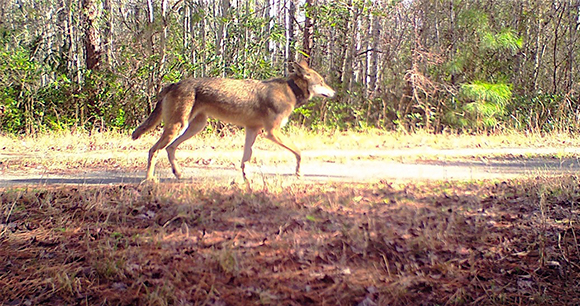by Dr. Ron Sutherland, Conservation Scientist, Wildlands Network
In 1987, eight years before gray wolves were released into Yellowstone National Park, the US Fish and Wildlife Service performed their first successful attempt at reintroducing a top carnivore into the wild. This took place not in the remote backcountry of the Rocky Mountains, but in the flat and swampy terrain of eastern North Carolina, where the Service decided to release red wolves into the Alligator River National Wildlife Refuge.

Unlike the situation in Yellowstone, when the red wolves were returned to North Carolina, no one apparently thought to do detailed before-and-after ecological surveys to assess the impacts the wolves might have on the local flora and fauna. Yellowstone, of course, had a long history of ecological research, whereas the dense “pocosin” swamp forests in eastern North Carolina were not nearly as well studied.
Now almost 30 years later, we still don’t know much about the red wolves and how they influence other species of wildlife and plants in North Carolina. This lack of knowledge is more than just academic, as the red wolf is now facing a serious political crisis. A few wealthy anti-wolf crusaders, along with political appointees on the North Carolina Wildlife Resources Commission, have spent the last few years aggressively pushing the Service to abandon the red wolf recovery field program. In 2014, a vocal wolf opponent decried the program as “the greatest wildlife disaster in the history of North Carolina” and claimed the wolves (and coyotes) have eaten all of the deer, leaving an empty forest that is no good for hunting.
Consequently, Wildlands Network was eager to start a field project in eastern North Carolina to investigate impacts of red wolves on the landscape. With support from AWI, we launched a pilot effort in the summer of 2015.
To date, we have established 22 motion-sensitive wildlife cameras at various points around the federal wildlife refuges (and a large tract of private land) in the red wolf recovery area. The captured images (available at http://www.flickr.com/photos/redwolfreality/albums) reveal an astounding density of large wildlife species: red wolves, deer, black bears, bobcats, coyotes, and even the occasional wild turkey. In 2016, we plan to continue the camera project and conduct more detailed assessments of other aspects of the region’s ecology, including bird and plant surveys. We also intend to examine a similarly sized control region outside the red wolf recovery area, where there are coyotes and bears but no red wolves. Thus, we hope to determine whether red wolves (typically 50–80 pounds) and coyotes (20–40 pounds) are having different impacts on deer and raccoon populations—impacts that might have cascading and contrasting effects on the plant and songbird communities.
This effort is urgent, as the Service estimates there are only 50-75 red wolves left in the wild (with approximately 200 wolves in captivity in zoos scattered around the country). If the North Carolina red wolf population is allowed to die off due to political pressure (and more directly, due to gunshot mortality that the state and the Service have done little to prevent), it is far from clear whether another attempt at recovering the red wolf in the wild will ever be made.